This article provides answers to some of the common questions on selection of appropriate clothes.
1.How is it that silk cloth possesses sheen, and yet is sattvik ?
Silk cloth is Sattva-Raja-predominant. The sheen is related to the Raja component. Only because the silk cloth is sattvik, the waves transmitted from it protect the wearer from negative energies. When sattvik Chaitanya in the form of Tej (Absolute Fire Principle) descends to perform its mission in a sagun (Materialised) form, its appearance is luminous. Silk cloth has predominantly Sattva-Raja components, and hence, it imbibes God’s Chaitanya in sagun form with the help of the Sattva component at the respective levels and swiftly emits it in the Universe with the help of the mobility of Raja component. That is why it appears luminous. Silk cloth has this capability, and hence, despite its glittering appearance, it is considered sattvik at the level of imbibing Chaitanya in sagun form.
2. Why using black colour is prohibited in Hindu Dharma ?
स्नानं दानं तपो होमः पितृयज्ञश्च तर्पणम् ।
पंच तस्य वृथा यज्ञा कृष्णवर्णस्य धारणात् ।। – (Smrutivachan)
Meaning : Religious rituals such as sandhya, bathing, donation, penance, sacrificial fire, Pitru-yadnya and tarpan become useless if performed while wearing black clothes. Black clothes are prohibited for Hindus. Wearing clothes with a black border is considered bad conduct. Wearing clothes with black fibers is a sin. Wearing black-colour turban, cap, handkerchief, shirt, saṛi causes unhappiness to Hindus who have faith in and abide by the religious scriptures. A simple washed cloth can be used as sovale, but a black cloth, even if it is washed and has come in contact with Holy objects, is still prohibited because of its colour. Preparing or serving food wearing black clothes is prohibited.
A. Spiritual reason for prohibition of black colour
Black has the highest ability to absorb Tama particles from the atmosphere. Hindu Dharma preaches how to increase sattvikta (Purity) through every act. Hence, Hindu Dharma considers black as inauspicious and that which should be discarded.
B. Adverse effects of wearing black clothes on an individual
-
The inertia in the black colour which is Tama-predominant being the reason why other colours cannot mix with it, and strained breathing being experienced upon looking at the colour : All colours (except black) created by God can mix with each other. A third colour is created by mixing two colours; however, no other colour can mix with black. It will remain black only. It is due to the inertia in the black colour (which is Tama-predominant) that it does not mix with other colours and it retains its primary existence. That is why, we experience strained breathing upon looking at the black colour.
-
Colours being symbolic of sagun-nirgun (Non-materialised) Principles of Deities and demons : Specific Principles can be identified with shades of respective colours; for example, red – Ganesh Principle, blue – Krushna Principle, grey – Shiva Principle, black – demon or negative energy.
-
The reason for an individual wearing black clothes : The mantriks first spread black (distressing) energy covering on the individual’s mind and intellect. Therefore, the individual wishes to wear black clothes. Similarly, the proportion of thoughts about Maya (The Great Illusion) and desires increases in his mind.
-
In keeping with the proverb that, ‘As are the thoughts, so are the tendencies and consequent action’, the Tama-predominant tendency of the individual leads to Tama-predominant action.
-
Colours not affecting the mind and intellect of an individual whose spiritual level is over 60 percent due to his internal sadhana (Spiritual practice); but his gross body getting affected : Colours do not affect the mind and intellect of an individual whose spiritual level is over 60 percent; because the mind and intellect are subtle. Similarly, since his internal sadhana is going on due to an increased spiritual level, the colours do not affect him. However, colours can affect his physical body; since the body is gross, the mantriks can instantly attack it.
3. How should the designs on the clothes be from the perspective of sattvikta ?
A. Designs should not be meaningless
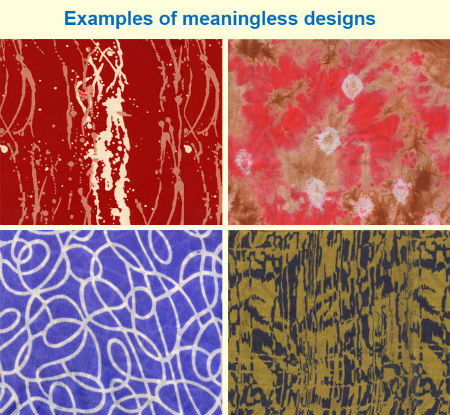
While selecting the designs on clothes, make sure they are meaningful, for example dots, leaves, flowers and vines.
B. Designs should not be too large
C. Designs should not have pointed tips
While selecting designs of flowers, leaves and vines, avoid designs containing leaves or flowers with pointed tips as is shown in the accompanying figure. Designs should be delicate and attractive.
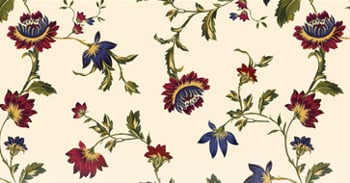
E. Designs should not be congested
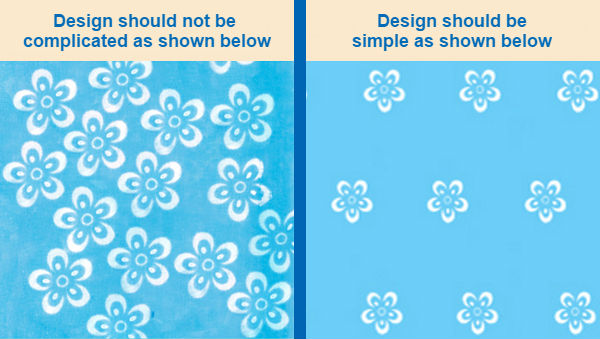
If the design is congested, it will emit waves of Shakti (Divine Energy). Sometimes, even good designs when placed too close to each other produce distressing vibrations. The more precise and well spread the design is, the closer it is to the nirgun Principle, and the vibrations emitted are better.
4. If there are stripes on clothes, how should they be – vertical, horizontal or oblique ?
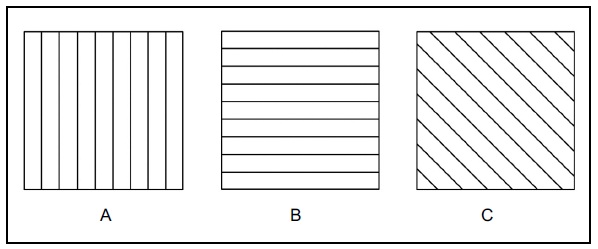
Look at figures ‘A’, ‘B’ and ‘C’ for 2 minutes each, experience what you feel and only then read further.
The feeling is most pleasant while looking at figure A, moderate while looking at figure B and that of distress while looking at figure C. When compared with horizontal lines, vertical lines emit vibrations that are more positive. The reason is that horizontal lines are associated with the Absolute Earth Principle, whereas vertical lines are associated with Absolute Ether Principle. The oblique lines emit mixed vibrations of the two directions and, as a result, they generate distressing vibrations. This only shows that it is appropriate to select clothes with vertical lines.
Lines, colour and Principle
| Lines | Colour | Principle |
|---|---|---|
| 1. Vertical | All the tarak colours | tarak (Saviour) |
| 2. Horizontal | Red | marak (Destroyer) |
Prakruti of an average individual is tarak, and hence, he/she may experience distress due to the marak Principle. Horizontal lines emit the marak Principle due to which the possibility of experiencing distress exists. Therefore, do not use clothes with horizontal lines.
5. Why are plain clothes more appropriate than clothes with designs ?
Clothes without any design are considered more sattvik. Being without any pattern, they pose no hindrance to attracting the flow of nirgun Chaitanya waves from the Universe. So also being ether-like, they pose no hindrance to emitting it optimally into the atmosphere according to the need of the activity. While selecting a design, it is necessary to check whether it is sattvik or not. No such problem arises with plain clothes. From this perspective, too, wearing plain clothes is beneficial.
6. Why should we not darn clothes while still wearing them ?
A continuous cloth is sattvik, while a cloth with many piercings carries distressing vibrations. The stitching process (though important from the perspective of imparting continuity to the cloth) is conducive to large-scale emission of Raja-Tama filled waves from the torn and pierced area. These Raja-Tama waves are emitted into the atmosphere in the form of a fountain during the process of stitching, and therefore, it is advisable that contact of the body with such distressing waves be avoided. Since the possibility of distress to the body due to the Raja-Tama-predominant process exists, avoid darning clothes while still wearing them.
Reference : Sanatan Sanstha’s Holy text ‘How should the clothes be from a spiritual perspective ?’


 Sewing Clothes and Effect of Stitching
Sewing Clothes and Effect of Stitching Practical suggestions on Wearing Clothes
Practical suggestions on Wearing Clothes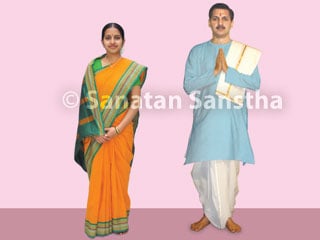 Why do we wear clothes ? and Importance of wearing Sattvik Clothes
Why do we wear clothes ? and Importance of wearing Sattvik Clothes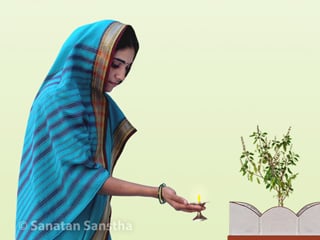 Significance of taking saree pallu (free end of the saree) over head
Significance of taking saree pallu (free end of the saree) over head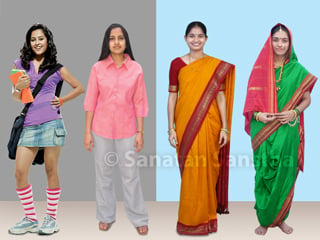 Subtle effect and Importance of dress worn by a woman
Subtle effect and Importance of dress worn by a woman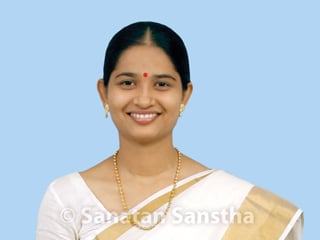 Subtle effects of different neckline patterns of a garment worn by women
Subtle effects of different neckline patterns of a garment worn by women